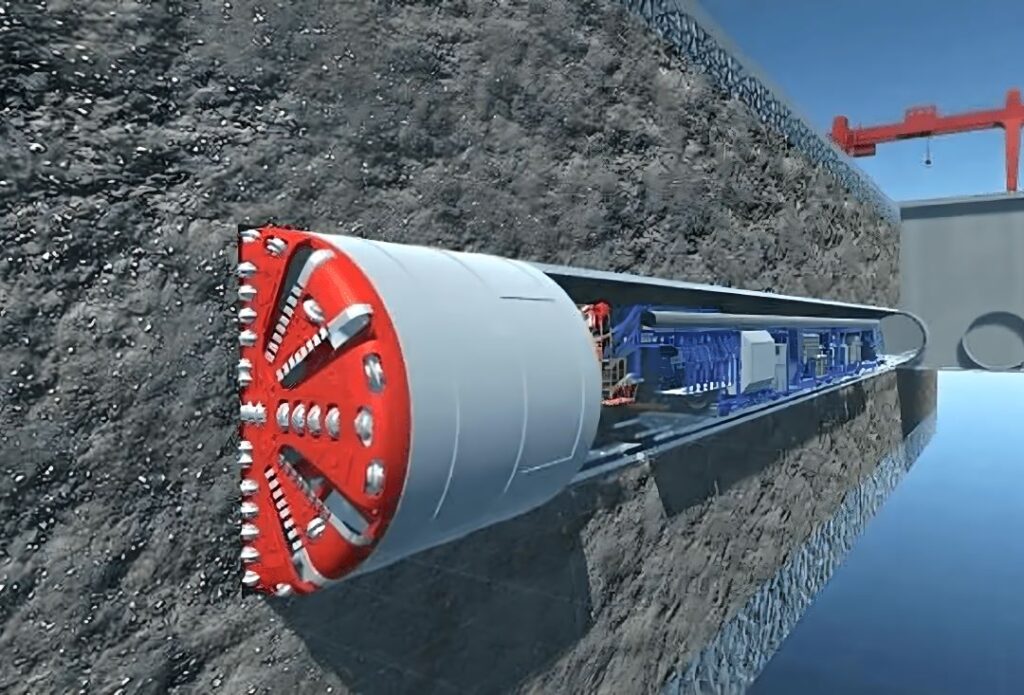A Tunnel Boring Machine (TBM) is a sophisticated piece of equipment used to excavate tunnels with a circular cross-section. It is commonly employed in the construction of transportation tunnels, such as those for railways and roads, as well as in utility tunnels for water, sewage, and other services. Here’s a detailed look at how they work。

I、Working principle
1. Cutting System
- Face Shield: The front of the TBM, known as the face shield, protects the cutting equipment and the machine's operators from the surrounding rock or soil.
- Cutting Wheels (Discs) or Cutterheads: Depending on the type of TBM (hard rock or soft ground), these components vary. Hard rock TBMs use rotating cutting wheels equipped with tungsten carbide or diamond-tipped teeth to grind through solid rock. Soft ground TBMs use a large rotating cutterhead studded with cutting tools that shear through soil and softer sediments.
2. Support System
- Gantry: The main body of the TBM, which houses the drive motors and support systems. It also provides a platform for the workers.
- Support Shields: These are used to stabilize the tunnel as the TBM advances. They are equipped with hydraulic jacks that press against the tunnel walls to maintain the TBM's position.
3. Excavation and Soil Removal
- Conveyor Belts: Excavated material is transported away from the cutting face using conveyor belts. This material is then transferred to a system of conveyors or muck cars that remove it from the tunnel.
- Auger Conveyors: In some TBMs, especially those designed for soft ground, an auger conveyor is used to remove soil that is too wet or loose to be handled by a conveyor belt.
4. Tunnel Lining
- Concrete Segments: As the TBM excavates, it installs precast concrete segments that form the tunnel’s permanent lining. The segments are lifted into place by cranes and bolted together to create a watertight seal.
- Spray Concrete: In some cases, particularly in hard rock tunnels, a layer of shotcrete is sprayed onto the tunnel walls to provide initial support until the permanent lining is installed.
5. Advancement and Steering
- Thrust System: Hydraulic jacks at the rear of the TBM push against the installed tunnel lining to move the machine forward.
- Steering Mechanism: TBMs are equipped with a steering mechanism that allows the operator to adjust the machine’s direction, ensuring it follows the intended tunnel alignment.
6. Power and Control Systems
- Electric Motors: TBMs are powered by electric motors, which are supplied with electricity from an external source via a cable.
- Control Room: A control room is located within the TBM, where operators monitor and control the machine’s functions. Modern TBMs often feature advanced computer systems that provide real-time data on the machine’s performance and the tunnel’s geology.
7. Environmental and Safety Features
- Dust Control: TBMs are equipped with dust control systems to maintain a safe working environment.
- Water Supply: A continuous supply of water is necessary for cooling the cutting tools and controlling dust.
- Emergency Systems: TBMs include safety features such as emergency exits and life support systems for the crew.
II、Working Process:
1. Cutterhead Operation:
- The TBM's cutterhead is equipped with disc cutters, which rotate and apply pressure to the tunnel face, breaking up the rock or soil. The type of cutters used depends on the ground conditions-softer soils may use cutting knives, while harder rock may require disc cutters.
2. Muck Removal:
- As the cutterhead cuts through the material, the muck (excavated debris) is collected and transported via a conveyor belt or screw conveyor system to the rear of the machine. From there, it is transferred out of the tunnel for disposal or reuse.
3. Thrusting:
- Hydraulic jacks in the thrust system push the TBM forward as the cutterhead rotates. The force needed to push the TBM is generated by pressing against the installed tunnel lining or temporary support structures.
4. Tunnel Support:
- As the TBM advances, it installs precast concrete segments to form a tunnel lining. These segments are assembled into rings, which provide structural support to the tunnel. The space between the lining and the excavated ground is usually filled with grout to prevent collapse and provide a watertight seal.
5. Steering and Navigation:
- The TBM is guided along a predetermined path using a sophisticated navigation system. Operators adjust the cutterhead angle, thrust pressure, and steering mechanisms to ensure the tunnel follows the planned alignment.
Tunnel Boring Machines are complex and sophisticated tools that have significantly improved the efficiency and safety of tunnel construction. Their ability to excavate through various types of terrain, from hard rock to soft soil, makes them





